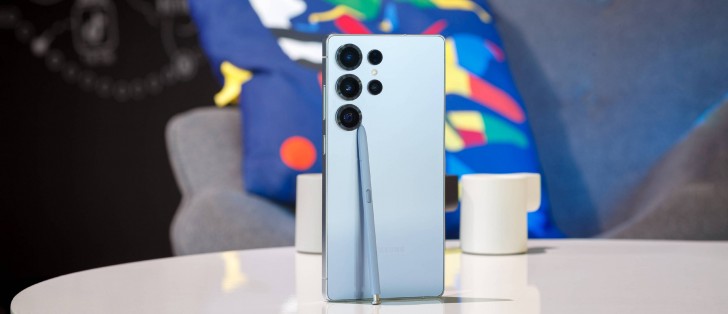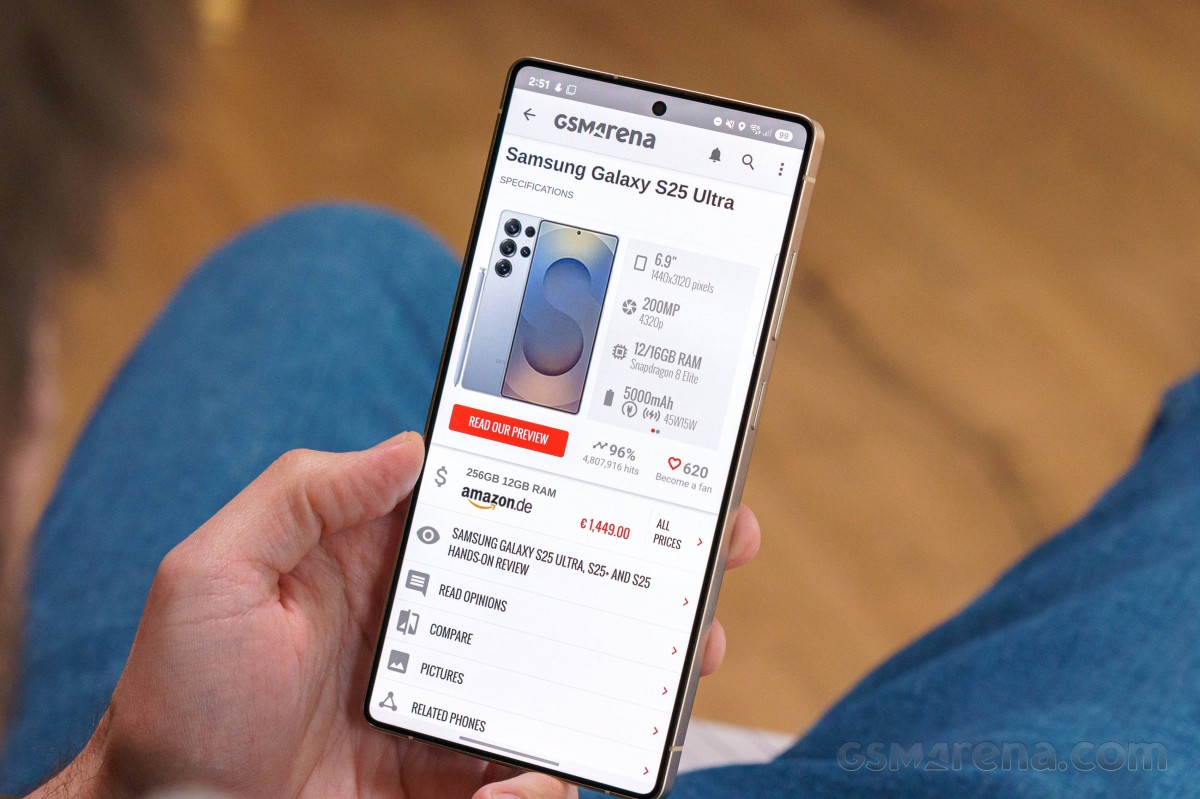Samsung Galaxy S25 Ultra review

Android 15 and One UI 7
The Galaxy S25 Ultra boots Android 15 with One UI 7. Samsung promises seven years of software support that includes both major Android updates and security patches.
Here's our One UI 7 review in mobile view format - watch it on your phone:
One UI 7 looks a lot like One UI 6 with its signature icons, widgets and wallpapers. The operational logic hasn't changed much - you still rely on your homescreens, app drawer, gestures or button navigation, and the drop-down area.
Android 15 has split the notification and quick toggles into two separate pages, like on the iPhones, and this change is also part of One UI 7. Now you drop the notification page from the top left part of the screen, and the expanded quick toggles page from the right part of the screen. That said, you still get the option to revert to a common interface showing both your quick settings and notifications.
Samsung provides a few custom apps like Gallery, My Files, Internet, Health, Calculator, Calendar, Wallet, the powerful Notes app, and its own Bixby assistant.
The entire Google suite is also pre-installed, plus a few Microsoft apps - Office, OneDrive, Outlook, LinkedIn.
The S Pen functionality has been reduced as it is no longer an active one - there is no battery supercapacitor, no gyro sensor, and no Bluetooth connectivity. You can still scribble, draw, and write (with handwriting recognition available in many languages). The usual functions such as Create Note, Screen Write (including Screen Off Memo), and write on Calendar are available.




Using S Pen in Notes and some AI tricks
There are some neat AI assist features now, which can help you summarize and translate texts, transform your doodles, and convert voice into text.
Google Gemini is at the heart of AI, as usual. You can ask Gemini a lot of stuff to do, even make entire conversations. It can give you ideas on what to cook based on a photo of your fridge contents, or you can ask for book or painting ideas. Gemini can also create images for you, which is neat.
Perhaps the most significant new addition is system-wide support for natural language input, enabling features like AI Agents, AI Select, additional Circle to search functionality, Gallery control and Cross-app Actions.
AI Select is an expanded feature built on the Smart Select functionality, which has been residing in the Side Bar of your Samsung smartphone for a while now. The AI can now analyze the screen's content in more detail and offer actions based on it. It can even create GIFs from Instagram reels or make wallpapers using a photo you have open on the screen.
Circle to search, which is a very similar feature, can now analyze not just the screen content but listen to an audio that's currently playing and provide information about the music track.
The natural language input allows you to control your phone in various ways. For instance, you can voice search your Gallery and ask the AI assistant to pull out photos from your trip to a particular place. You can even ask it to enlarge the font if it's too small, although this is likely a limited feature to system menus only.
The Cross-app Action is arguably the most exciting feature of them all. Imagine you have a virtual concierge or personal assistant. You can ask it to search for a restaurant nearby, find it on Google Maps and share its location with a friend. You can make notes on the fly, make calls, save calendar events and set up an alarm clock at the appropriate time.
This is quite impressive as the system is now seemingly capable of more complex tasks involving changing system settings and interacting with multiple apps, and all of that works with natural language input.
For now, the feature is available only with Samsung One UI system apps and Google apps, but Samsung promises to introduce support for third-party apps, including WhatsApp and Spotify to name a few.
The Gallery Generative Edit is quite powerful - it can add or remove people and objects, with their shadows, of course. It also allows you to sketch some things and add them to your photo.
Some personalized AI features are also at hand, such as Now Brief and Now Bar. Now Brief offers a summary of your daily schedule - for example, in the morning, it will summarize your last night's sleep, give you a quick brief look at your daily appointments and even let you know whether your favorite podcasters or artists have released new content. It will also come up at noon and in the evening to help you stay on top of things.
The Now Bar has a similar concept, except that it lives on your lockscreen and focuses on current apps and events. It will provide contextual information like what song you are playing, turn-by-turn directions from Google Maps with a suggested departure time so you are not late for your meeting, and even keep up to date with live score updates on your favorite sports team.
Samsung's DeX functionality is still part of One UI 7. You can connect a monitor, wired or wirelessly, to your Galaxy, and expand its Android capabilities in a desktop-like interface with windows and everything. The PC support for DeX is gone now, and Samsung suggests the Galaxy users should use the updated Link to Windows app by Microsoft instead. The app offers the same features as the PC DeX, for seamless PC-to-phone and vice versa transfers.
With all these powerful AI features, the phone collects a lot of personal data, which is then used to improve your experience. Not all of the number-crunching is done in the cloud. So, it's only natural to wonder whether your data is safe. Samsung guarantees the safety of your information using Samsung Knox Matrix and Vault. All the personal information and preferences are stored on the device and encrypted with quantum computing standards in mind.
Performance and benchmarks
The Galaxy S25 Ultra employs the 3nm Snapdragon 8 Elite chipset, probably the most powerful SoC any Android phone can enjoy right now. It's a "Snapdragon 8 Elite for Galaxy", meaning the two prime CPU cores are clocked higher (4.47 GHz vs. 4.32 GHz), and the Adreno GPU runs at higher clock speeds. Interestingly, Samsung mentions improvements in the NPU as well, but we don't have the details now.

The Elite chip uses Oryon processor cores, two versions of them - two Prime cores and six Performance cores. These aren't Cortex cores like in MediaTek and Samsung Exynos chipsets, but a custom Qualcomm design. The two Prime cores run at up to 4.47GHz, while the Performance cores are clocked at 3.53GHz.
Then there's the Adreno 830, which is built on a new architecture using a sliced design with dedicated memory for each slice. The 830 has three of these slices clocked at up to 1.2GHz.
The Galaxy S25 Ultra is available with 256GB (as reviewed), 512GB and 1TB UFS 4.0 storage, while the RAM is always the same - 12GB LPDDR5X.
The Galaxy S25 Ultra and its Snapdragon 8 Elite show excellent performance capabilities by delivering chart-topping results in our CPU and GPU tests, though the Antutu result doesn't exactly excite. The Dimensity 9400 chip delivers similar GPU scores, but the CPU inside the Snapdragon is clearly superior.
The sustained performance is similar to the Galaxy S24 Ultra's - there is 41% CPU performance loss and 50% GPU performance drop. The phone gets warm under continuous stress testing, but never hot.
While the Galaxy S25 Ultra has the best hardware on the mass market right now, the sustained performance isn't ideal - the behavior is similar to most flagships, yet somehow it's a little worse here. Sure, anecdotally, when it comes to long gaming sessions, we never observed visible throttling or stutter, which should be enough for most practical purposes.
Reader comments
- xPandamon
- 14 May 2025
- JHj
It still is square, way more than the other models. It just has slightly rounded corners now. Also no, it is very different from the iqoo 13.
- K9krowl
- 12 May 2025
- KZK
3 months in with a 512GB unit. Pros: Great display & pretty snappy with barely any lag. Battery life isn't spectacular but sufficient for whole day before plugging in. Charging with an Anker GaN 40W is super duper fast. Can go from 2...





































